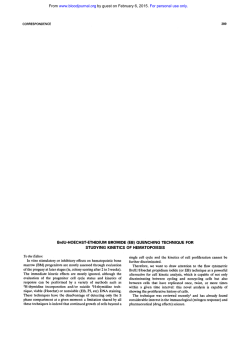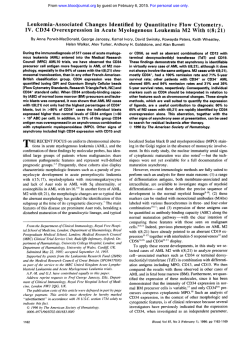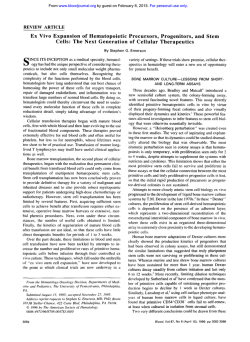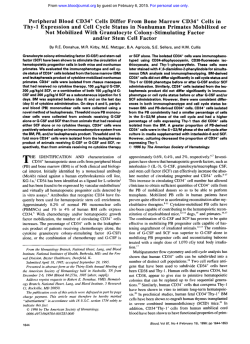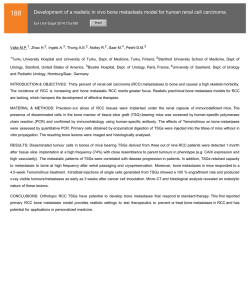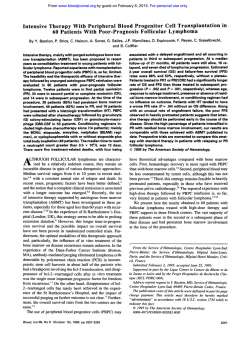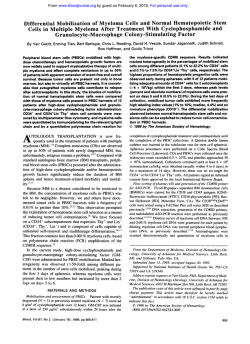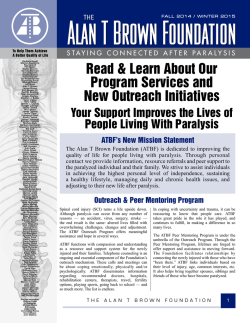
A Functional Comparison of CD34+CD38
From www.bloodjournal.org by guest on February 6, 2015. For personal use only. A Functional Comparison of CD34+CD38- Cells in Cord Blood and Bone Marrow By Qian-Lin Hao, Ami J. Shah, Flavia T. Thiemann, Elzbieta M. Smogorzewska, and Gay M. Crooks We present cell cyclingandfunctionalevidence that the CD34+CD38- immunophenotype can be used to define a rare and primitive subpopulationof progenitor cells in umbilical cord blood. CD34+CD38- cells comprise 0.05% f 0.08% of the mononuclear cells present in cord blood.Cell cycle analysis with the fluorescent DNA stain 7-aminoactinomycin D showed that the percentage of CD34+ cells in cycle directly correlated with increasing CD38 expression. CD34+CD38cord blood cells were enriched for long-termculturainitiating cells (LTCIC; cells able to generate colony-forming unitcells [CFU-Cl after 35 to 60days of coculturewith bone marrow stroma) relative to CD34+CD38+ cells. In an extended LTCIC assay, CD34+CD38- cells were able to generate CFUC between days 60 and 100,clearly distinguishingthem from CD34+CD38+cells that did not generate CFU-C beyond day 40. When plated as single cells, onset of clonal proliferation was markedly delayed in a subpopulation of CD34+CD38cells; clones (defined as >l00 cells) appeared after60 days of culture in 2.9% of CD34+CD38- cells. In contrast, 100% Of CD34+CD38+ cells formed clones by day 21. Although the CD34TD38- immunophenotypedefineshighlyprimitive populations in both bone marrow and cord blood,important functional differences exist between the two sources. CD34+CD38- cordblood cells haveahighercloning efficiency, proliferate more rapidly in responseto cytokine stimulation, and generate approximately sevenfold more progeny than do their counterpartsin bone marrow. 0 1995 by The American Society of Hem8tology. U Umbilical cord blood was obtained after vaginal and cesarean deliveries at Kaiser Permanente Hospital Sunset (Los Angeles, CA) after clamping and cutting of the cord by drainage of blood into sterile collection tubes containing the anticoagulant citrate-phosphate-dextrose (Sigma, St Louis, MO). All bone marrow and cord blood specimens were obtained according to guidelines approved by the Childrens Hospital Los Angeles Committee on Clinical Investigation. Cells were processed within 24 hours of collection. Fluorescent antibody labeling and cell sorting. Mononuclear cells (MNC) were isolated from bone marrow and cord blood using Ficoll Hypaque (Pharmacia, Piscataway, NJ) density centrifugation. After lysis of residual red blood cells with Ortho Lysis buffer (Ortho Diagnostic Systems, Inc, Raritan, NJ), the mononuclear cells were washed and resuspended in cold (4°C) phosphate-buffered saline (PBS) at a concentration of 106cellsper 100 pL for incubation with fluorescent-labeled antibodies. In each of the cell sorting experiments, 2 X lo6 cells (200 pL) were incubated for 30 minutes at 4°C in 20 pL undiluted fluorescein isothiocyanate (FlTC)-labeled antiCD34 (FITC-HPCA2; Becton Dickinson Immunocytometry Systems [BDIS], San Jose, CA) and 20 pL undiluted phycoerythnn (PE)conjugated anti-CD38 (PE-leu 17; BDIS). Aliquots of lo6cells used for isotype controls were incubated for 30 minutes in 50 pL of FITC-murine IgG (diluted 1:100; Coulter, Hialeah, FL) and 50 pL of PE-murine IgG (diluted 1:50). After incubation, cells were washed once in PBS. All fluorescence-activatedcell sorting (FACS) analysis and cell sorting was performed on a FACSVantage (BDIS) equipped with an argon laser tuned to 488 nm. To determine the frequency of CD34+ subpopulations in each sample, 50,000 events were acquired in listmode data file. Further analysis was performed on cells MBILICAL CORD BLOOD is attracting increasing interest as a source of hematopoietic stem cells (HSC) for gene therapy. Although previous studies have provided functional characterization of the committed progenitor (CD34+) population in cord blood, relatively little is known about the more primitive subpopulations presentin cord blood that are enriched for HSC."3 The immunophenotypic characterization and determination of the cycling and growth characteristics of the most primitive progenitors present in cordblood are essential steps toward assessment of cord blood HSC as potential targets for gene therapy. One immunophenotype commonly used to identify HSC in adult bone marrow has been found not to apply to cord blood HSC. CD34' bone marrow cells with low or absent expression of HLA-Dr antigen are enriched for primitive blast-cell-containing colonies, high proliferative potentialcolony-forming cells (HPP-CFC), and long-term culture-initiating cells (LTCIC)."6 However, in cord blood, the converse appears to apply, ie, the HLA-Dr+ subpopulation of CD34+ cells is more primitive thanthe CD34+HLA-Drpopulation.' The CD34+CD38- immunophenotype defines a primitive subpopulation of progenitor cells in fetal liver, fetal bone marrow, and adult bone m a r r ~ w . ~In" this ~ report, we have studied the cell cycle status and generative capacity of CD34+CD38- and CD34+CD38+ cells incordbloodand compared them with their counterparts in adult bone marrow. The CD34TD38- immunophenotype defines a rare, quiescent subpopulation in both cord blood and bone marrow that can be distinguished functionally from the CD34+CD38+ population by sustained clonogenicity in an extended longterm culture assay. Late onset of proliferation from a small percentage of CD34+CD38- cells contributesto the prolonged generation of colony-forming unit-cells (Cm-C) for 60 to 100 days of long-term culture. Althoughthe CD34TD38- immunophenotype is consistent in both cord blood and bone marrow in defining the most primitive progenitors, functional differences between CD34+CD38- cells from the two sources exist that have important implications for gene therapy. MATERIALS AND METHODS Cell sources. Bone marrow was obtained from consenting healthy adult volunteers by aspiration from the posterior iliac crest. Blood, Vol86, No 10 (November 15). 1995: pp 3745-3753 From the Division of Research Immunology and Bone Marrow Transplantation and the Division of Hematology/Oncology, Childrens Hospital L o s Angeles, Los Angeles, CA. Submitted April 14, 1995; accepted July 13, 1995. G.M.C. is the recipient of a Basil O'Connor Starter Scholar Research award from the March of Dimes Birth Defects Foundation. Address reprint requests to Gay M. Crooks, MD, Division of Research Immunology and BoneMarrow Transplantation, Childrens Hospital L o s Angeles, " 5 2 , 4650 Sunset Blvd, L o s Angeles, CA 90027. The publication costs of this article were defrayed in part by page charge payment. This article must therefore be hereby marked "advertisement" in accordance with 18 U.S.C.section 1734 solely to indicate this fact. 0 1995 by The American Society of Hematology. 00"4971/95/8610-0022$3.00/0 3745 From www.bloodjournal.org by guest on February 6, 2015. For personal use only. HA0 ET AL 3746 Bone Marrow 8 CD34-FITC Forward Scatter Cord BI o.od B .. W 4 03 p3 cl 0 4 .:.... ..:.. ... I 9 400 ' 660 660 l& Forward Scatter after gating on the lymphoid region (R1 in Fig 1A). Quadrants were defined using isotype controls. In the cell sorting experiments, CD34'CD38- cells were defined strictly as those with high CD34 antigen expression and anti-CD38 PE fluorescence less than half of the maximum PE fluorescence of the isotype control (R2 in Fig 1B). To analyze the HLA-Dr expression of the CD34'CD38- population, cells were incubated with FITC-CD34, PE-CD38, and antiHLA-Dr directly labeled with peridinin chlorophyll protein (PerCP; BDIS) and analyzed by FACS using an argon laser. FACS unalysis qf cell cycling. 7-amino actinomycin D (7-AAD) is a fluorescent DNA stain with an emission spectrum that allows its use in triple color analysis in combination with FITC- and PEconjugated monoclonal a n t i b ~ d i e s . ' ~To " ~analyze cell cycle status CD34-FITC Fig 1. FACS analysisof cord blood and bone marrow MNC. (A) Forward scatter (site) and side scatter (density) of bone marrow and cord blood MNC is shown showing region RI in which CD34+ progenitor cells are located. (B) CD34 and CD38 expression of bone marrow and cord blood cells from region R I . Quadrants are defined by FITC- and PElabeled isotype controls (see Materials and Methods). Region W , used t o define CD34TD38- cells for sorting experiments, is defined as CD34' cells with PE-CD38 fluorescence less than half maximum PE fluorescence of the isotype control. Region R3 was used to define CD34+CD38' cells for sorting experiments. of CD34' subsets, cells were initially incubated with FITC-antiCD34 and PE-anti-CD38 or with the isotype controls as described above and then fixed in cold 0.5% paraformaldehyde (Sigma) for 60 minutes at 4°C. They were then washed once in PBS, resuspended in 0.05% Tween 20 (Aldrich Chemical, Milwaukee, WI) at a cell concentration of 5 X 106/mL,and incubated at 37°C for 15 minutes. After permeablization, cells were washed twice in PBS and resuspended in 500 pLof PBS with 25 pL of 500 pg/mL7-AAD (Molecular Probes Inc, Eugene, OR) per 10' cells. The cells were incubated in 7-AAD for 20 minutes at room temperature and then immediately analyzed by FACS. Cell cycle analysis was performed using a FACWantage equipped with an argon laser tuned at 488 nm and PC Lysys software program (BDIS). Fifty thousand to 200,000 events From www.bloodjournal.org by guest on February 6, 2015. For personal use only. 31 41 CD34+CD38- CELLS IN CORD BLOOD l Fig 2. 7-AAD cell cycling assay. (A) FACS analysis showing CD34 and CD38 expression of MNC (from region R1, Fig 1A) that have been stained with the DNA fluorescent stain 7-AAD. Quadrant markersare defined by FlTC and PE fluorescence of isotype controls that have also been stained with theDNA stain 7-AAD. Region R2 defines CD34TD38- cells. RegionR3 defines CD34'CD38+ cells.Region R4 defines CD34+CD38di" cells. (B) Histogram showing 7-AAD fluorescence of bone marrow MNC from R1 (Fig 1A). M 1 defines cellsin Go/G, phase. M 2 defines cellsin S phase. M 3 defines cells in GJM phase. L 4 a" 0 A FITC-CD34 gated from R1 (defined by forward and side scatter in Fig 1) were acquired on listmode data files. To increase the number of events for analysis, 10,000 events gated from the CD34' cell population were also acquired. Regions defining GdG, phase, S phase, and GJ M phase were set using total mononuclear cells as an internal control (Fig 2B). The cell cycling status of the three subpopulations of CD34+ cells (ie, CD38', CD3gd'"', and CD38- shown in Fig 2A) was then separately analyzed by determining the 7-AAD fluorescence of cells from each immunophenotypic gate (regions R2, R4, and R3, respectively, in Fig 2A). CD34+CD38d'" cells were those CD34' cells with CD38-PE expression less than the maximum background fluorescence of the isotype control but greater than half the maximal fluorescence of the isotype control. Chicken erythrocyte nuclei (CEN; DNA QC particle kit; BDIS) were used as a positive control for 7-AAD staining. Long-term stromal cultures and methylcellulose cultures. Bone marrow stroma was produced by culturing fresh mononuclear bone marrow cells in stromal medium (12.5% horse serum, 12.5% fetal calf serum [FCS; Gemini Bioproducts, Calabasas, CA], Iscoves modified Dulbecco's medium [IMDM, GIBCO BRL, Bethesda, MD], 2-mercaptoethanol (Sigma), molL hydrocortisone [Sigma], penicillidstreptomycin, and glutamine) for atleast 3 weeks. Macrophages were depleted from the stromal cultures by trypsinizing and replating at least four times before final use in the long-term cultures. One to 2 days before cell sorting, allogeneic bone marrow stroma was irradiated with 20 Gy and plated (7 X lo3 cells/well) in 96-well plates (Falcon; Becton Dickinson Labware, Lincoln Park, NJ) to form pre-established stromal layers for the long-term cultures. Two hundred to 500 cells (with either the CD34'CD38- or CD34'CD38+ immunophenotype) were sorted into individual wells of the 96-well plates in quadruplicates and cultured on the irradiated stroma in long-term bone marrow culture (LTBMC) medium (IMDM, 30% FCS, 1% bovine serum albumin [BSA; Sigma], 2mercaptoethanol [Sigma], molL hydrocortisone [Sigma], penicillidstreptomycin, glutamine, and the combination of 10 ng/mL interleukin-3 [IL-3],50 U/mL IL-6, and 50 ng/mL Steel factor [SFJ). Every 2 to 3 weeks, nonadherent cells were removed and counted and aliquots were replated in two different concentrations each in duplicate into semisolid media (1.3% methylcellulose in LTBMC medium with IL-3, IL-6, SF, granulocyte-macrophage colony-stimulating factor [GM-CSF; 50 ng/mL], and 2 U/mL erythropoietin). CFU-C were counted after a further 14 days and the mean of quadruplicates was recorded. Cloning ejjiciency of CD34+CD38' and CD34+CD38- cells. To compare the cloning efficiency of CD34+CD38+and CD34TD38cells from cord blood and bone marrow, single cells were deposited in each well of 96-well plates using the Automated Cell Deposition Unit (ACDU) of the FACSVantage. The culture plates were prepared 1 to 2 days before cell sorting with LTBMC medium containing IL3, IL-6, SF, and pre-established, irradiated BM stromal layers, as described above. Cultures were fed twice weekly by replacing half the supernatant with fresh LTBMC medium. The plates were counted every 7 days, and wells were recorded as positive if greater than 100 cells were present. Cloning efficiency was defined as the number of positive wells + total wells X 100%. RESULTS Frequency of CD34'CD38- cells in cord blood and bone marrow. Thefrequency of CD34+CD38- cellsincord blood and bone marrow was determined by FACS analysis using the quadrants defined in Fig 1. The quadrant defining cells negative for CD34 and CD38 was setto include at least 99% of cells stained with the isotype control. The percentage of CD34' cells was lower in cord bloodMNC than in bone marrow (mean, 0.36% of cord blood MNC v 1.63% of bone marrow MNC), with a large variation in thecord blood samples (range, 0.02% to 1.43%; Table 1). The frequency of CD34TD38- cells, defined by isotype control quadrants, was similar in cord blood and bone marsow (mean, 0.05% from both sources) because of a relatively higher proportion of CD34+ cells with the CD38- immunophenotype in cord blood. isolation of CD34+ subpopulations by FACS. CD34'CD38- cells isolated by FACS sorting for further analysis From www.bloodjournal.org by guest on February 6, 2015. For personal use only. H A 0 ET AL 3748 and culture were defined as those CD34' cells with PECD38 fluorescence less than one half the PE isotype control (region R2in Fig 1B). Using this stringent definition, a consistent frequency of CD34TD38- cells was found within the total mononuclear cell fraction from cord blood and bone marrow (0.02% ? 0.01% for both cord blood and bone marrow; Table 1). Region R3 wasusedtodefine CD34+CD38+cells. HLA-Dr and lineage-specijic antigen expression of cord blood CD34+CD38- cells. To determine the HLA-Dr expression of cord blood CD34TD38- cells, MNC were stained with FITC-CD34, PE-CD38, and PerCP-HLA-Dr and analyzed by triple-color flow cytometry. Cells falling in the CD34TD38- R2 gate showed a homogeneously low to negative HLA-Dr expression falling in the proximity of the isotype control marker. The CD34TD38- cells with low HLA-Dr expression comprised less than 10% of the total CD34+HLA-Dr+ cells (data not shown). Cell cycle status of CD34+CD38- cells in bone marrow and cord blood. 7-AAD, a fluorescent DNA stain, permits determination of the cell cycle status of rare cells defined by dualcell surface antigen expression. To study the relationship of cell cycle status to CD38 antigen expression in CD34+ cells, we analyzed the 7-AAD fluorescence on each of the three CD34+ subpopulations (CD38+, CD38d'm,and CD38-) shown in Fig 2A (definedin the Materials and Methods). In both bone marrow and cord blood, the percentage of CD34+ cells in cell cycle (S-GJM phase) increased as CD38 antigen expression increased (Fig 3). A lower percentage of the more primitive CD34+CD38- cells was cycling than either the CD34+CD38+ cells or the CD34+CD38"'" cells. Although there was sample-to-sample variation in the percentage of cells cycling, the positive correlation between CD38 antigen expression and cell cycling was maintained in each sample. A relationship between 7-AAD and PECD38 fluorescence was not seen in the CD34- population, showing that 7-AAD fluorescence wasnotan artefact of spectral overlap with PE. A small percentage of CD34+CD38- cells (5.4% ? 1.8%, mean ? SD) was cycling in all cord blood samples. These results contrasted with those found for the CD34TD38cells in bone marrow, in which no cycling was seen in four samples and 2% of cells were in cycle in the fifth sample. The CD34+CD38- phenotype enriches for cells with high and prolonged generative capacity in extended long-term culture. Having established that increasing CD38 expression correlates with an increasing percentage of CD34' cells in cycle, we chose to use a stringent definition of negative Table 1. Frequency of CD34' and CD34TD38- Cells in Cord Blood and Bone Marrow MNC % of Total M N C (mean i SDI CD34+ CD34TD38- Bone marrow (n = 16) Cord blood (n = 30) 1.63 ? 0.96 0.36 ? 0.33 (region R2) 0.02 0.01 0.02 2 0.01 % cells m * in S-G2/M 20 10 0 cord blood bone marrow Fig 3. Cell cycle analysis of fresh cord blood and bone marrow CD34' subpopulations. Using the DNA stain 7-AAD, cell cycle status was determined for each of the (B) CD34+CD38-, (0)CD34+CD38dim, and ( W ) CD34+CD38+subpopulations defined by regionsR2, R4, and R3 respectively in Fig 2A. The vertical axis shows the percentage of eachsubpopulation in S-G2/M (defined by M2-M3 inFig 2Al. The mean 2 SD for each subpopulation is shown (n = 5 bone marrow samples, n = 5 cord blood samples).The percentage of CD34TD38' cells in S-GJM issignificantlyhigher than the percentage of CD34TD38- cells in S-GJM in both cord blood and bonemarrow by paired t-test ( * P = .021. CD38 expression to isolate and assay the functional characteristics of the most quiescent population of CD34TD38cells. We compared the generative capacity (ie, the ability to generate nonadherent cells and CFU-C) of both CD34+CD38- (from R2 in Fig 1B) and CD34+CD38' cells (from R3) from cord blood and bone marrow. The sorted populations were cultured on irradiated bone marrow stroma in the presence of IL-3, IL-6,and SF, a combination that we have previously found to allow maximal cloning efficiency and cell proliferation from primitive progenitors. At 2 to 3-week intervals, aliquots of nonadherent cells were removed from the stromal cultures, counted, and plated in methylcellulose medium to measure the progenitor content of the cultures. In cultures from both bone marrow and cord blood, the total expansion of nonadherent cells was significantlygreater when initiated with CD34+CD38- cells than with CD34+CD38+cells (Fig 4). The time course of cell expansionwas strikingly different between the two subpopulations. Maximal expansion from CD34+CD38+cells occurred around day 30. In contrast, cell expansion from CD34+CD38- cells peaked later, between days 60 and 80 of culture. Paralleling the differences in the production of nonadherent cells, there was a marked difference in the level and persistence of CFU-C production by the CD34TD38- cells and CD34'CD38+ cells. Figure 5 shows representative experiments from a total of five cord blood and seven bone marrow samples. The magnitude of CFU-C expansion varied between experiments, but a pattern of prolonged C m - C production exclusively from CD34+CD38- cells was consistently seen. By extending the period of long-term culture, From www.bloodjournal.org by guest on February 6, 2015. For personal use only. 3749 CD34+CD38- CELLS IN CORD BLOOD Bone marrow A 1000 0 20 60 40 80 100 120 Day of long termculture Cord blood B m l 800 0 O 0 8 " 0 20 4600 60 100 120 Day of long term culture + Fig 4. Nonadherent cell expansion fromI 1 CD34+CD3SCand ( i l l CD34+CD38- cells. CD34+CD38' and CD34*CD38- cellsfrombone marrow (AI and cord blood (B) were plated in quadruplicate on day 0 by FACS sorting onto preestablished irradiated allogeneic stroma at 500 cellslwell in a 96-well plate. Cells were cultured on stroma in LTBMC mediumwith IL-3.11-6, and SF (see Materials and Methods). Every 2 to 3 weeks, nonadherent cells were removed from each culture and counted. The mean fold increase over cell number plated on day 0 is shown at each time point of long-term culture. we were able to compare CFU-C production from each subpopulation during the standard 35- to 56-day period of the LTCIC assay with production during extended long-term culture (E-LTC), ie, between days 60 and 100. We hypothesized that hematopoiesis during E-LTC may be initiated from a more primitive subpopulation of progenitor cells (ELTCIC) than standard LTCIC. CFU-C production (both the percentage and thetotal number of CFU-C) from CD34TD38- cells from both bone marrow and cord blood was higher than that from CD34+CD38+ cells after 35 days of culture, indicating enrichment of LTCIC in the CD34TD38- population. The most striking difference in CFU-C production between the CD34'CD38+ and CD34+CD38- cells from both bone marrowandcordbloodwasseen after 40 days of culture. CFU-C were produced beyond day 40 only from cultures initiated with CD34TD38- cells. CFU-C numbers from each CD34+CD38- culture showed a biphasic pattern, with an early peak around day 40 to 50 and a later peak occurring between days 40 and 80. CFU-C production from CD34+CD38- cells persisted for 80 to 120 days of culture. The pattern of prolonged CFU-C production from E-LTC distinguished CD34TD38- cells from CD34'CD38+ cells more clearly thandid CFU-C production during the standard LTCIC assay period of 35 to 56 days. Lute appearance of clones from single cord blood CD34+CD38- cells in extended long-term culture. TO study whether the prolonged CFU-C production from bulk cultures of CD34+CD38- cells was due to persistent proliferation from highly clonogenic progenitors or to the sequential recruitment of different subpopulations, the timing ofclonal proliferation from individual cord blood CD34TD38- cells was determined. Single cord blood CD34+CD38- or CD34+CD38+ cells were placed byFACS into individual wells of 96-well plates prepared withirradiated bone marrow stroma and IL-3, IL-6, and SF. Each well was recorded as positive if at least 100 cells were visible at any time point. Every 1 to 2 weeks, the appearance ofnew positive wells was notedto determine the onset of clonal proliferation from each CD34TD38- and CD34+CD38+cell. The number of wells in which proliferation first appeared ateach time point is shown as a percentage of total wells plated (Fig 6). All of the clones arisingfrom CD34+CD38+ cells and most of the clones arising from CD34TD38- cells appeared in the first 21 days of culture. However, 2.9% 2 3.1% (mean rt SD) of all CD34+CD38- cells plated on day 0 began to proliferate after 60 days of culture, and 1.9% t 2.6% of all cells plated initiated proliferation after 80 days (n = 1,344 wells/experiment; 2 experiments). Late-proliferating clones did not arise from the CD34+CD38+ cells in cord blood. To assess the secondary replating potential of clones present duringthestandardLTCICperiod(35to56days)andto compare them with those present during the E-LTCIC period, we removed cells from positive wells (ie, those that contained viable hematopoietic cells) at days 45 and 88 and replated them in methylcellulose medium. Thuty-six percent of the wells initiatedwith CD34TD38- cellswerepositiveatday 45, and 13.2% of the positive wells gave rise to CFU-C. Thus, 4.7% (0.36% X 13.2%) of all CD34TD38- cells plated generated CFU-C in the standard LTCIC assay. By day 88 (in E-LTC), 24.2% of all wells still contained viable cells. Of the positive wells,2.1%were abletogiverisetoCFU-C. Thus, 0.5% (0.24% X 2.1%)ofallcordblood CD34TD38- cells were able to generate CFU-C in E-LTCIC assay. Cloning eficiency and generative capacity of CD34' CD38- cells from cord blood is greater than thatfrom bone marrow. Having established that the CD34+CD38- immunophenotype definesa rare, quiescent, and functionally primitive population in cord blood as it does in bone marrow, we next determined whether there are functional differences between the two sources of CD34+CD38- cells. The cloning efficiency (ie, the number of cells able to proliferate in culture) of CD34TD38- cells from cord blood was compared with thatfrom bone marrow.Single CD34+CD38- cells from bonemarrowandcordbloodweresortedandculturedin . From www.bloodjournal.org by guest on February 6, 2015. For personal use only. 3750 H A 0 ET AL Cord Blood #2 Cord blood #l 1 Fig 5. CFUG expansion from (D) CD34+ CD38- cells in extended long term culture. CD34+CD38+and CD34+CD38- cells were plated in quadruplicate on day 0 by FACS sorting onto preestablished ir. radiated allogeneic stroma at 500 cellslwell in a S w e l l plate. Cells were cultured on stromain LTBMC medium with 11-3,IL-6, and SF. To measura CFU-C production from the long-term cultures, every2 to 3 weeksnonsdherent cells were removed and counted, aliquots were replated in quadruplicates in mathylcellulose medium,andCFU-Cwere counted after a further 14 days of culture. Thevertical axes represent CFU-C expansion during long-term culture (calculated as mean percentage of CFU-Cper nonadherent cells plated in rnethylcellulosa x mean fold expansion of nonadherent cells [Fig 41 at each time point). Three independentexperiments with cord blood and one repmsentative experiment with bone marrow are shown. ( 61 CD34+CD38+and ' 0 40 20 60 Day of long term culture Cord blood 13 Bone marrow WO 500 - 400300200 - Day of long term culture IL-3, L-6, and SF either with or without irradiated stroma. CD34+CD38+cells were also sorted as single cells to compare cloning efficiency of the committed progenitors with their primitive CD38- counterparts. Cloning efficiency was defined as the percentage of wells with at least 100 cells present at day 28. The cloning efficiency of CD34+CD38- cells from cord blood was significantly higher than that of CD34+CD38cells from bone marrow (on stroma, 36.8% 2 2.9% v 5.9% 2 0.3%, respectively, P < .Owl; without stroma, 41.8% 5 9.1% v 0.9% ? 0.1%, P < .0001; Fig 7). Cloning efficiency of cord blood CD34+CD38- cells was not significantly different than thatfor cord bloodCD34+CD38+cells. However, inbonemarrow, there wasasignificantlylower cloning efficiency from CD34+CD38- cells than from CD34+CD38+ cells ( P < .OOOl). The effect of stroma on cloning efficiency of CD34+ CD38- cells differed between cord blood and bone marrow. Cocultivation of cells with bone marrow stroma increased cloning efficiency of bone marrow CD34+CD38- cells sixfold (P = .001), but did not significantly enhance the plating efficiency of cord blood CD34+CD38- cells. The cloning efficiency of CD34+CD38+ cells from either cord blood or bone marrow was not significantly affected by the presence of stroma. 80 100 l20 The onset of proliferation of CD34+CD38- cells from cord blood wasearlier than from bone marrow CD34+CD38cells. Single CD34TD38- cells from cord blood formed clones of at least 100 cells per well as early as 7 days in culture. In contrast, bone marrow CD34+CD38- did not form clones until approximately 21 days (data not shown). Individual cord blood CD34+CD38- cells had a greater generative capacity than those in bone marrow (Table 2). Clones produced from single cord blood CD34+CD38- cells contained sevenfold more cells than those from bone marrow. CD34+CD38- cells from both bone marrow and cord blood produced respectively 10-fold and threefold morecells than did CD34+CD38+cells from each source, again showing the higher generative capacity of the more primitive CD34TD38- cells. DISCUSSION These studies show thatthe CD34+CD38- immunophenotype defines a rare and highly primitive population of cells in cord blood. CD34+CD38- cells are distinct from the more numerous CD34+CD38+ progenitors on the basisoftheir cell cycling status and their capacity to generate progeny over an extended period of long-term culture. The CD34+CD38- immunophenotype is consistent in definining a highly primitive subpopulation of CD34' cells in From www.bloodjournal.org by guest on February 6, 2015. For personal use only. CD34TD38- CELLS IN CORDBLOOD IT 3751 TT 20 10 Blood Cord 0 7 5 11 4 38 21 65 95 88 81 Day of culture Fig 6. Timing ofappearance of newclones from single cord blood (B) CD34+CD38- and ( W ) CD34+CD38+cells. Pre-established irradiated allogeneic stroma was plated in each well of a 96-well plate. Individual CD34TD38-and CD34'CD38' cord bloodcells were plated by FACS as single cells per well onto stroma using the ACDU of the FACSVantage. For each experiment, a totalof 1,344 wells were plated with CD34TD38- cells and 192 wells were plated with CD34+CD38+ cells. Cells were cultured in LTBMC medium inIL-3, IL-6, and SF (see Materials and methods) for I 2 0 days with twice weekly changes of half the medium. Approximately once per week, all plates were scored for positive wells (100 cellslwell plated) and wells that had become positive since the previousscoring were recorded. The vertical axis represents the percentage of all wells plated that became positive at each time point. Mean values SD are shown for t w o independent experiments. * all sources of HSC studied to date, ie, fetal liver, fetal bone marrow, adult bone marrow, and cord blood.*"* In contrast, HLA-Dr expression on highly primitive progenitors varies with each hematopoietic source.6-8,''Our studies show that CD34+CD38- cells in cord blood have homogeneous low HLA-Dr expression. In these studies, we have defined an immunophenotypically homogeneous population of cells. However, at least two functionally distinct subpopulations exist within the CD34+CD38- cells of bone marrow and cord blood, ie, those able to produce C m - C within the standard LTCIC assay period (5 to 8 weeks) and a more rare subpopulation that begins to proliferate in culture after 8 weeks (the period of extended long-term culture). Although the CD34+CD38population is enriched for CFU-C that appear during the standard LTCIC period, it is the ability to produce CFU-C beyond 8 weeks that most clearly distinguishes the primitive CD34TD38- bone marrow and cord blood cells from the more mature CD34+CD38+ cells. Consistent with this prolonged progenitor output is the late appearance of blast cell clones arising only from single cells with the CD34+CD38immunophenotype. These late-appearing clones presumably represent the same highly primitive progenitor cells that contribute to the CFU-C during the extended LTCIC period. The purification of functionally distinct subpopulations of CD34+CD38- cells by immunophenotypic or other biologic markers will be an important step in the further study of quiescent HSC. Bone Marrow Fig 7. Comparison ofcloning efficiency of CD34+CD38- and CD34+CD38+cells from cord blood and bone marrow. Wells of 96well plates were prepared with LTBMC medium and IL-3, IL-6, and SF, either with or without irradiated stroma. Individual CD34TD38and CD34+CD3Sf from cord blood or bone marrow were plated by FACS as single cells per well as described in Fig 6. Cloning efficiency was definedas the percentage of wells with at least 100 cells present at day 28. For each experiment, a mean of 992 wells were plated with CD34+CD38- cells and 188 wells were platedwith CD34+CD38+ cells from cord blood and from bone marrow. The results shownare the mean k SD from three experiments with bone marrow and t w o * P < .0001, significant difference of plating efficiency with cord blood. between CD34+CD38- cells from bone marrow and from cord blood (grown either with or without stroma) by paired t-test. ' P < .0001, significant difference between CD34+CD38- cells and CD34TD38' cells in bone marrow 2 stroma. < ,001. significant difference between bone marrow CD34TD38- cells grown on stroma compared with those grown without stroma. (m) CD34+CD38- with stroma; ) CD34+CD38- without stroma; (M) CD34+CD38+with stroma; ( W CD34+CD38+without stroma: Several observations support the contention that cells assayed during extended long-term culture may represent a different and possibly more primitive population than those measured over the standard LTCIC period. First, the delayed clonogenicity of E-LTCIC suggests a deeply quiescent cell population that is relatively less responsive to cytokine stimulation than the standard LTCIC. Second, using a retroviral vector to mark CD34+CD38- bone marrow cells, we have found that the level of transduction of CFU-C produced after 8 weeks of culture (0% to 5 % ) is significantly lower than transduction of CFU-C during the first 8 weeks of culture (40% to 60%; manuscript in preparation). The lower transduction efficiency of E-LTCIC is consistent with a target population more quiescent than standard LTCIC. A transduction efficiency of less than 5% in E-LTCIC is also compara- Table 2. Generative Capacity of Individual CD34+CD3Sf and CD34+CD38- Cells From Cord Blood and Bone Marrow Cell No. From Each Clone (XlO'l Sinole Cells Plated Cord Blood Bone Marrow CD34+CD38+ CD34+CD38- 75 -t 33 208 2 302 31'2 28 2 36 Values shown are mean -t SD for bone marrow clones (n = 15) and cord blood clones (n = 59). From www.bloodjournal.org by guest on February 6, 2015. For personal use only. 3752 HA0 ble to that seen for HSC in vivo in large animal studies and clinical human gene therapy trials.’”” Finally, a hierarchical system of pluripotent hematopoietic progenitor cells has been described in murine studies with a functional distinction shown between day 12 CFU-spleen (CFU-S) cells and the more quiescent and primitive long-term repopulating cells?”23 Although the CD34TD38- immunophenotype defines a functionally primitive subpopulation in cord bloodand bone marrow, important differences exist between the CD34+CD38- cells from each source. Consistent with other reports, we found that both committed and primitive progenitors from cord blood proliferate more rapidly in response to cytokine stimulation in vitro than their counterparts in bone marrow?7 The more rapid onset of proliferation in vitro is partly due to the larger percentage of cord blood HSC cycling in vivo but is also because of a greater capacity of quiescent cord blood cells to respond to stimulation. Not only do a significantly higher percentage of cord blood CD34TD38cells proliferate in vitro, but each cord blood cell (whether CD34+CD38+ or CD34+CD38-) can generate almost a log more progeny than its counterpart in bone marrow. These biologic differences between highly primitive cells in cord blood and bone marrow mayhave important implications for human gene therapy. The results of human clinical trials using retroviral vector-mediated transduction of bone marrow have been disappointing, with low or absent transduction of long-lived progenitors. The quiescent nature of hematopoietic stem cells in bone marrow is likely to be the major obstacle to efficient retroviral-mediated gene transfer?4,25Successful transduction of long-lived progenitors has been achieved in one clinical gene therapy trial using cord blood and in another using bone marrow from patients recovering from c h e m ~ t h e r a p y . ~In~ ~each ~ ’ case, it is likely the increased efficiency of transduction resulted from a higher percentage of cycling HSC. To induce proliferation of HSC from normal bone marrow with the current array of cytokines available, prolonged in vitro stimulation is likely to be necessary, leading inevitably to cell differentiation and loss of stem cell function. The highly proliferative HSC of cord blood may thus provide a more promising target for HSC gene therapy. ACKNOWLEDGMENT The authors thank Geralyn Annett and Dr Michael Lill for their invaluable technical assistance and Dr Robertson Parkman and Dr Donald B. Kohn for advice on preparation of the manuscript. Special thanks is given to the staff of Labor and Delivery, Kaiser Sunset Permanente, Los Angeles for their generous assistance in providing umbilical cord blood for use in these studies. REFERENCES 1. LuL, Xiao M, Grigsby S, Wang WX,WuB, Shen R-N, Broxmeyer HE: Comparative effects of suppressive cytokines on isolated single CD34+++ stedprogenitor cells from human bone marrow and umbilical cord blood plated with and without serum. Exp Hematol 2111442, 1993 2. Lu L, Xiao M, Shen R, Grigsby S, Broxmeyer HE: Enrichment, Characterization, and responsiveness of single primitive CD34“’ human umbilical cord blood hematopoietic progenitors with high proliferative and replating potential. Blood 81:41, 1993 ET AL 3. Hows JM, Bradley BA, MarshJCW, Luft T, Coutinho L, Testa NG, Dexter TM: Growth of human umbilical-cord blood in longterm haemopoietic cultures. Lancet 340:73, 1992 4. Lu L, Walker D, Broxmeyer HE, Hoffman R, Walker E: Characterization of adult human marrow hematopoetic progenitors highly enriched by two-color cell sorting with My10 and major histocompatibility class I1 monoclonal antibodies. J Immunol 139:1823, 1987 5. Sutherland HJ, Eaves CJ, Eaves AC, Dragowska W, Lansdorp PM: Characterization and partial purification of human marrow cells capable of initiating long-term hematopoiesis in virro. Blood 74: 1563, 1989 6. Srour EF, Brandt JE, Briddell RA, Leemhuis T, vanBesien K, Hoffman R: Human CD34’HLA-DR- bone marrow cells contain progenitor cells capable of self-renewal, multilineage differentiation, and long-term in vitro hematopoiesis. Blood Cells 17:287, 1991 7. Traycoff CM, Abboud MR, Laver J, Brandt JE, Hoffman R, Law P, Ishizawa L, Srour E F Evaluation of the in vitro behavior of phenotypically defined populations of umbilical cord bloodhematopoietic progenitor cells. Exp Hematol 22:215, 1994 8. Muench MO, Cupp J, Polakoff J, Roncarolo MC: Expression of CD33, CD38, and €EA-DR on CD34’ human fetal liver progenitors with a high proliferative potential. Blood 83:3170, 1994 9. Terstappen L W “ , Huang S, Safford M, Lansdorp PM. Loken MR: Sequential generations of hematopoietic colonies derived form single nonlineage committed progenitor cells. Blood 77: 1218, 1991 10. Huang S, Terstappen LWMM: Lymphoid and myeloid differentiation of single human CD34+, HLA-DR’, CD38’ hematopoietic stem cells. Blood 83:1515, 1994 1 1. Rusten LS, Jacobsen SEW, Kaalhus 0, Veiby OP, Funderud S, Smeland EB: Functional differences between CD38- and DR. subfractions of CD34’ bone marrow cells. Blood 84:1473, 1994 12. Reems JA, Torok-Storb B: Cell cycle and functional differences between CD34+/CD38h’andCD34’/CD38Iohumanmarrow cells after in vitro cytokine exposure. Blood 85:1480, 1995 13. Issaad C, Croisille L, Katz A, Vainchenker W, Coulombel L: A murine stromal cell line allows the proliferation of very primitive human CD34+/CD38- progenitor cells in long-term cultures and semisolid assays. Blood 81:2916, 1993 14. Schmid I, Uittenbogaart CH, Giorgi JV: A gentle fixation and permeabilization method for combined cell surface and intracellular staining with improved precision in DNA quantification. Cytometry 12:279, 1991 15. Stokke T, Hoke H, Steen HB: In vitro and in vivo activation of B-lymphocytes: A flow cytometric study of chromatin structure employing 7-aminoactinomycin D. Cancer Res 48:6708, 1988 16. Stokke T, Hoke H, Erikstein B, de L.Davies C, Funderud S, Steen HB: Simultaneous assessment of chromatin smcture, DNA content, and antigen expression by dual wavelength excitation flow cytometry. Cytometry 12:172, 1991 17. Schuening FG, Kawahara K, Miller AD, To R, Goehle S, Steward D, Mullally K, Fisher L, Graham TC, Appelbaum F R , Hackman R, Osborne WRA, Storb R: Retrovirus-mediated gene transduction into long term repopulating marrow cells of dogs. Blood 78:2568, 1991 18. Carter RF, Abrams-Ogg ACG, Dick JE, Kruth SA, VaIli VE, Kamel-Reid S, Dube ID: Autologous transplantation of canine longterm marrow cells genetically marked by retroviral vectors. Blood 79:356, 1992 19. Kantoff PW, Gillio A, McLachlin JR. Bordignon C, Eglitis MA, Kernan NA, Moen RC, Kohn DB, Yu SF, Karson E, Karlsson S, Zwiebel JA, Gilboa E, Blaese RM, Nienhuis A, O‘Reilly RJ, Anderson W: Expression of human adenosine deaminase in nonhuman primates after retroviral mediated gene transfer. J Exp Med 166:219, 1987 From www.bloodjournal.org by guest on February 6, 2015. For personal use only. 3753 CD34TD38- CELLS IN CORDBLOOD 20. Dunbar CE, O'Shaughnessy JA, Cottler-Fox M, Carter CS, Doren S, Cowan KH, Leitman SF, Wilson W, Young NS, Nienhuis AW: Transplantation ofretrovirally-markedCD34'bonemarrow andperipheralbloodcellsinpatientswithmultiplemyelomaor breast cancer. Blood 82:217a, 1993 (abstr, suppl 1) 21. Hodgson GS, Bradley TR: Properties of haematopoietic stem cells surviving 5-fluorouracil treatment: Evidence for a pre-CFU-S cell? Nature 281:381, 1979 22. Jones RJ, Wagner JE, Celeno P,Zicha MS, Sharkis SJ: Separation of pluripotent haematopoietic stem cellsfrom spleen colonyforming cells. Nature 347:188, 1990 23. Li CL, Johnson GR: Long-term hemopoietic repopulation by Thy-l'", Lin-, Ly6A/E+ cells. Exp Hematol 20:1309, 1992 2 4 . Miller DG, AdamMA, Miller AD: Gene transfer by retrovirus vectors occurs only in cells that are actively replicating at the time of infection. Mol Cell Biol 104239, 1990 25. Springett GM, Moen RC, Anderson S , Blaese RM, Anderson WF: Infection efficiencyof T lymphocytes with amphotropic retroviral vectors is cell cycle dependent. J Virol 63:3865, 1989 26. Kohn DB, Weinberg KI, Nolta JA, Heiss LN, Lenarsky C, CrooksGM,Hanley ME, AnnettG,Brooks JS, El-KhoureiyA, Lawrence K, Wells S , Moen RC, Bastian J, Williams-Herman DE, Elder M, Wara D, Bowen T, Hershfield MS, Mullen CA, Blaese RM, Parkman R Engraftment of gene-modified umbilical cord blood cells in neonates with adenosine deaminase deficiency. Nature Med 1995 (in press) 27. Rill DR. Santana VM, Roberts Nilson T, Bowman LC, Krance RA, Heslop HE, Moen RC, Ihle JN, Brenner MK Direct marrow transplantation for solid demonstration that autologous bone tumors can return a multiplicity of tumorigenic cells. Blood 84:380, 1994 WM. From www.bloodjournal.org by guest on February 6, 2015. For personal use only. 1995 86: 3745-3753 A functional comparison of CD34 + CD38- cells in cord blood and bone marrow QL Hao, AJ Shah, FT Thiemann, EM Smogorzewska and GM Crooks Updated information and services can be found at: http://www.bloodjournal.org/content/86/10/3745.full.html Articles on similar topics can be found in the following Blood collections Information about reproducing this article in parts or in its entirety may be found online at: http://www.bloodjournal.org/site/misc/rights.xhtml#repub_requests Information about ordering reprints may be found online at: http://www.bloodjournal.org/site/misc/rights.xhtml#reprints Information about subscriptions and ASH membership may be found online at: http://www.bloodjournal.org/site/subscriptions/index.xhtml Blood (print ISSN 0006-4971, online ISSN 1528-0020), is published weekly by the American Society of Hematology, 2021 L St, NW, Suite 900, Washington DC 20036. Copyright 2011 by The American Society of Hematology; all rights reserved.
© Copyright 2025
